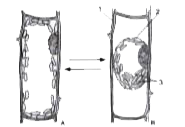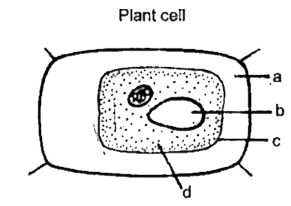A cell kept in a solution increases in volume. The solution is
Hypotonic
Isotonic
Hypertonic
Either A or B
The correct Answer is:A
To determine the type of solution in which a cell increases in volume, we can follow these steps:
1. Understand the Types of Solutions: There are three types of solutions in relation to a cell:
- Isotonic: The concentration of solutes is the same inside and outside the cell, resulting in no net movement of water.
- Hypotonic: The concentration of solutes is lower outside the cell than inside. This causes water to move into the cell.
- Hypertonic: The concentration of solutes is higher outside the cell than inside. This causes water to move out of the cell.
2. Analyze the Question: The question states that a cell kept in a solution increases in volume. This indicates that water must be entering the cell.
3. Identify the Correct Solution Type:
- In a hypotonic solution, water moves from an area of lower solute concentration (outside the cell) to an area of higher solute concentration (inside the cell). This influx of water causes the cell to swell and increase in volume.
- In an isotonic solution, there is no net movement of water, so the cell's volume remains the same.
- In a hypertonic solution, water moves out of the cell, leading to a decrease in volume.
4. Conclusion: Since the cell is increasing in volume, it must be in a hypotonic solution.
Final Answer:
The solution is hypotonic.
---
- Isotonic: The concentration of solutes is the same inside and outside the cell, resulting in no net movement of water.
- Hypotonic: The concentration of solutes is lower outside the cell than inside. This causes water to move into the cell.
- Hypertonic: The concentration of solutes is higher outside the cell than inside. This causes water to move out of the cell.
- In a hypotonic solution, water moves from an area of lower solute concentration (outside the cell) to an area of higher solute concentration (inside the cell). This influx of water causes the cell to swell and increase in volume.
- In an isotonic solution, there is no net movement of water, so the cell's volume remains the same.
- In a hypertonic solution, water moves out of the cell, leading to a decrease in volume.
The solution is hypotonic.
Topper's Solved these Questions
- TRANSPORT IN PLANTSBOOK - DINESH PUBLICATION ENGLISHCHAPTER - TRANSPORT IN PLANTSEXERCISE - CHECK YOUR GRASP
40 Videos
- TRANSPORT IN PLANTSBOOK - DINESH PUBLICATION ENGLISHCHAPTER - TRANSPORT IN PLANTSEXERCISE - CHECK YOUR GRASP
40 Videos
- THE LIVING WORLDBOOK - DINESH PUBLICATION ENGLISHCHAPTER - THE LIVING WORLDEXERCISE - Check your grasp
12 Videos
- VERTEBRATA-AGNATHA AND PISCESBOOK - DINESH PUBLICATION ENGLISHCHAPTER - VERTEBRATA-AGNATHA AND PISCESEXERCISE - Check Your Grasp
12 Videos
Similar Questions
Knowledge Check
When a cell is kept in a 0.5 M solution of Sucrose, its volume does not alter if the same cell is placed in 0.5 M solution of sodium chloride its volume
AincreasesBdecreasesCdoes not show any changeDnone of the above
In the given figures 'A' shows a cell in the normal state and 'B' shows the same cell after leaving it in a certain solution for a few minutes :

Was the solution isotonic, hypotonic or hypertonic in which the cell was kept ?
View SolutionA cell increases in volume if the external medium is
View SolutionCompare the cells kept in isotonic, hypotonic and hypertonic solutions.
View SolutionAs the solute concentration in a solution increases, the change that does not occur is
View SolutionThe osmotic pressure of a solution increases if
View SolutionIf cells kept for sometime in 1M solution of sucrose and 1M solution of NaCl. The water potential (Ψw) of the cells kept in:
View SolutionStudy the diagram given alongside showing a plant cell kept in a strong sugar solution.

What will happen to this cell if it is kept in water?
View Solution
